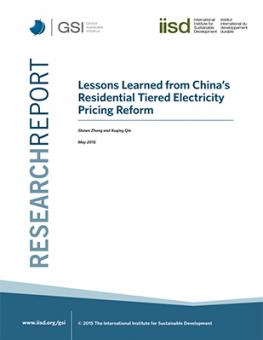
Lessons Learned From China's Residential Tiered Electricity Pricing Reform
Because electricity is an essential commodity for everyday life, the Chinese government mostly regulates its retail price. This paper reviews and evaluates the tiered electricity pricing reform in China, examining the impacts on equity, efficiency and subsidy expenditure.
Because electricity is an essential commodity for everyday life, the Chinese government mostly regulates its retail price.
In order to ensure that all sections of society can access electricity affordably, pricing is done in blocks so that the poor, who consume less, pay less. Under such a tiered electricity pricing (TEP) system, electricity consumers pay a low rate for an initial consumption block and a higher rate as they increase use beyond that block. TEP is widely used by power sector regulators and can, if properly designed, improve equity by providing the poor with subsidized rates, while maintaining economic efficiency (i.e., avoiding overconsumption) and limiting subsidy expenditure. In October 2010, China introduced a TEP pricing reform for the residential sector in accordance with an official document (No. [2010] 2617) issued by China’s National Development and Reform Commission. Previously, households were charged a flat rate, which varied by province, regardless of how much each consumed.
This paper reviews and evaluates the TEP reform, examining the impacts on equity, efficiency and subsidy expenditure. It also looks at how problems associated with the reform were addressed, and the form and mode of communication with stakeholders.
You might also be interested in
Heatwaves to hit China once every 5 years as global extreme weather events multiply, study finds
Record-breaking heatwaves that have scorched North America, Europe and China are set to worsen in future unless the world stops burning fossil fuels, according to a study by the World Weather Attribution (WWA) academic initiative.
Transition from fossil fuels to renewable energy can pose fiscal challenges for India: study
The global transition away from fossil fuels to renewable energy sources could trigger financial challenges for India and major developing countries such as Russia, Brazil and China because of their high dependence on revenues from fossil fuel, according to a study by the International Institute for Sustainable Development (IISD).
IISD Report: Shifting Away from Fossil Fuels Could Lower BRIICS Nations' Revenues
A new report by the International Institute for Sustainable Development (IISD), titled Boom and Bust: The Fiscal Implications of Fossil Fuel Phase-Out in Six Large Emerging Economies, looks at the potential financial ramifications of phasing out fossil fuels in six emerging economies — Brazil, Russia, India, Indonesia, China, and South Africa (BRIICS). They must begin adjusting their fiscal policies to account for declining fossil fuel use or risk a $278 billion revenue gap by 2030.
India, 5 others face fall in fossil fuel revenues
As the global clean energy transition gathers pace, six emerging economies need to start adjusting their fiscal policies now to account for declining fossil fuel use-or risk a $278 billion gap in revenues by 2030, equivalent to the combined total government revenues of Indonesia and S. Africa in 2019, according to a new report by the International Institute for Sustainable Development.